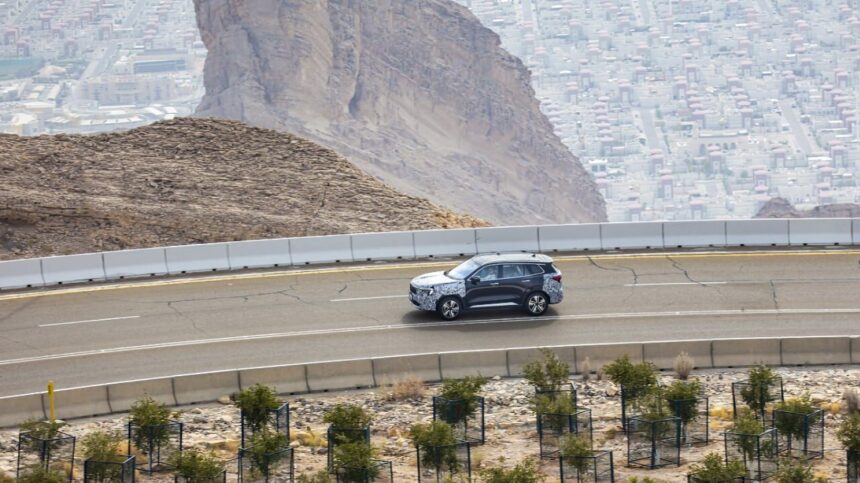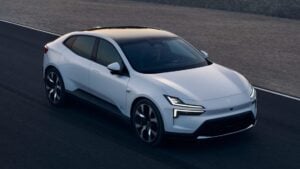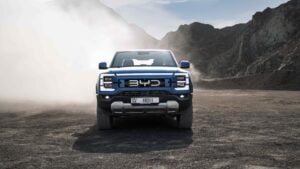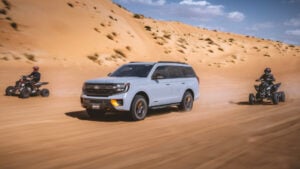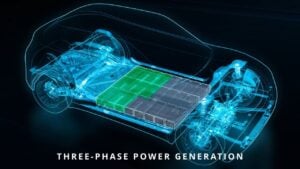Driving in the Middle East and North Africa means melting heat, swirling sands and brutal terrain. Yet, Ford says its compact SUV, the Territory, is purpose‑built to handle it all. This isn’t marketing fluff—they’ve tested every detail under harsh desert conditions. Below, we unpack what that means for you and why it matters.
Hot‑Weather Testing You Can Trust
Ford puts the Territory—and its hybrid sibling—through gruelling trials in Dubai heat.
- Continuous testing in 50 °C-plus sun
- Engine, cooling, AC and cabin materials all scrutinised
- Over‑time stress tests mimic years of wear
Technicians drive the vehicle over tarmac and gravel under direct sunlight, monitoring engine temperature, oil pressure and coolant performance. At the same time, the air conditioning system is pushed to deliver icy relief within moments—even under the most intense conditions. These aren’t simulations: local Ford engineers have 15 years of hands‑on experience in MENA, so their standards aren’t based on guesswork but on lived realities.
Desert, City, and Everything In Between
But it isn’t just about baking the SUV in the sun. The testing routine is relentless: scorching desert runs, city congestion, slow traffic, and open highway—all to expose every possible weakness. In the deep, power-sapping sands, driving is like dragging a weight through syrup: the engine and transmission strain harder, generating even more heat, while slower speeds mean less airflow over radiators. That’s why cooling circuits, fan speeds, and coolant chemistry get tweaked again and again until the vehicle shrugs off the worst the desert can throw at it.
Inside, the cabin faces its own torture. Engineers let the SUV soak with the engine off and windows closed, then blast the AC on full—expecting cool air in seconds, not minutes. Temperatures inside can hit a staggering 72 °C (162 °F) before the system is unleashed. The goal: whether you’re stuck in stop‑start traffic in Dubai or navigating dusty streets in Cairo, the climate control needs to hit your chosen temperature every time, no matter how brutal the sun.
City traffic isn’t ignored, either. Slow-moving jams put extra strain on powertrain cooling and climate control, while mountain highways add a layer of punishing climbs and descents—each demanding flawless stability from the engine, body, and chassis.
Inside the cabin, the heat is just as relentless. Engineers let the vehicle bake under the sun with the engine off and windows closed for over an hour, then blast the AC on max to see how fast it can cool a sweltering interior. During these “soak” tests, cabin temps have climbed to a staggering 72 °C (162 °F), making those first few seconds of cool air make-or-break for comfort.
All this on-the-ground torture testing complements the digital side of development—computer-aided design and engineering help speed things up, but real-world extremes reveal the issues that only emerge under relentless MENA heat.
Tackling Deep Sand: The Hidden Challenge
Navigating deep, soft sand is more than just a test of driver skill—it’s a workout for your vehicle. Picture hauling a loaded suitcase across a sandy beach; the extra effort it takes to move is similar to what your car experiences. The tires dig in, resistance climbs, and suddenly every system—from the engine to the transmission—is under significant additional stress.
With the sun blazing overhead, this challenge intensifies. Lower driving speeds in thick sand result in less airflow over radiators and under the chassis, making it more challenging for the cooling system to perform its job. As a result, heat builds up rapidly. These conditions force every component—from oil and coolant pumps to thermostats and fans—to work overtime to keep temperatures in check. For engineers, ensuring reliable cooling isn’t just about comfort; it’s essential for keeping your vehicle performing safely, even when the desert throws its worst at you.
City traffic isn’t ignored, either. Slow-moving jams put extra strain on powertrain cooling and climate control, while mountain highways add a layer of punishing climbs and descents—each demanding flawless stability from the engine, body, and chassis.
Inside the cabin, the heat is just as relentless. Engineers let the vehicle bake under the sun with the engine off and windows closed for over an hour, then blast the AC on max to see how fast it can cool a sweltering interior. During these “soak” tests, cabin temps have climbed to a staggering 72 °C (162 °F), making those first few seconds of cool air make-or-break for comfort.
All this on-the-ground torture testing complements the digital side of development—computer-aided design and engineering help speed things up, but real-world extremes reveal the issues that only emerge under relentless MENA heat.
Why Real-World Testing Still Matters
Computer modelling tools like CAD and CAE have revolutionised how engineers design vehicles. They can simulate thousands of scenarios, helping teams identify potential problems early and refine parts well before a single prototype is released. It means you catch design flaws faster, test materials virtually, and speed up development.
But here’s the catch: No matter how advanced simulations get, nothing compares to the intensity of real life—especially when you’re up against relentless desert sun, suffocating heat, and dust storms that sneak into every crevice. Digital tools can’t fully predict how rubber fades, plastics warp, or electronics misbehave after months under a 50 °C sky. There are always surprises you can only find out by actually driving vehicles straight into those extreme conditions.
So, while modelling brings speed and precision to the drawing board, real-world testing in punishing environments is what verifies your SUV’s actual readiness for everyday life in the region. It’s this on-the-ground grit that separates a good design from a desert-proof one.
Real-World Environments: Putting Cooling and Comfort Systems to the Test
Testing in the searing desert is just the start. To truly guarantee performance, vehicles are also driven through crowded city streets, wide‑open highways, and challenging mountain climbs. Each setting brings its own torture for critical systems.
- City driving piles on the heat as engines idle in traffic, stop‑start movement stresses cooling systems, and air conditioning must keep the cabin cool when ventilation is limited. It’s the ultimate challenge for any powertrain to avoid overheating while you’re stuck behind a lorry in rush hour.
- Highway runs crank up the speed and sustain high RPMs, forcing engines and drivetrains to work overtime while still demanding a cool, comfortable interior.
- Mountain routes are notorious for their steep inclines, which test the endurance of the engine, transmission, and cooling circuit, all while pushing the suspension and handling to their limits.
By weaving together these environments—city, highway, and mountain—engineers ensure every component endures both relentless sun and real‑life driving demands. No detail escapes scrutiny, from noise and vibration to ride quality and the ability of climate control systems to deliver frosty air as temperatures soar.
Engine & Cooling: Staying Cool When It Matters
Small engines lose power in extremely hot temperatures. That’s why Ford focuses on:
- Precise engine temperature monitoring
- High‑capacity cooling circuits
- Heat‑stress oil and pressure tests
They take thermal readings constantly during desert blasts. If the cooling system falters even slightly, they tweak fan speeds, radiator flow or coolant chemistry. The result? A powertrain that stays stable even in stop‑start traffic or highway climbs steeped in desert sun.
Pushed to the Limit
Extreme sand driving means slower speeds and higher engine loads—so the cooling system can’t rely on fast airflow alone. The team tracks performance even when the Territory is slogging through dunes at a crawl, making sure heat build-up never leads to a dropout in power or reliability.
AC System: More Than Just Cold Air
In MENA climates, air‑conditioning is not optional—it’s vital. Ford’s tests include:
- Fast‑start cool‑down checks
- Dehumidifying for clear windows
- Long‑runtime tests under engine stress
Engineers measure how long it takes the cabin to drop to a comfortable 24 °C. They also test the system’s ability to remove moisture—important for visibility and avoiding clammy interiors. And they do it all under continuous 50 °C+ engine heat, so you get a cabin that’s cool from day one, not just after you’ve driven out of the ignition zone.
No Room for Error
To replicate the worst-case scenario, vehicles are left soaking in the sun with the engine off and windows closed for over an hour. The record? A sweltering 72 °C (162 °F) inside. Only then does the AC get fired up—on max—to see how fast it brings temperatures down to comfort. Whether you’re in Dubai, Durban or Darwin, the expectation is the same: set the temperature and trust the car to deliver, every time.
Interiors Built to Last
The desert sun is brutal on interiors. Ford’s focus:
- UV‑stable plastics and fabrics
- Heat‑treated leather
- Material stress testing in extreme cycles
They use lab equipment to mimic years of UV exposure, checking for cracking, brittleness, discolouration or warping. Some plastics are reformulated for UV resistance, and leathers are treated to resist drying. All interior materials used in the Territory go through the same lab and field trials as the mechanical parts.
Lab and Real‑World Validation
UV-stress machines first torture materials—like the ones used by furniture brands and luxury automakers—then left to bake under Dubai’s relentless sun. Only parts that survive both make it into the final product, ensuring the Territory’s cabin stays sharp and comfortable after years in the wild.
What It All Means for Drivers
Every part of the Ford Territory is refined for desert life. What does that give you:
- Reliable engine and cooling in nonstop heat
- Air‑conditioned comfort as soon as you hop in
- Cabin that still looks good after long exposure
- Drive‑confidence even on gravel or dunes
By testing under real‑world extremes, Ford engineers in Dubai deliver a vehicle that lasts and performs for years—even in MENA’s toughest months.
And while computer-aided design (CAD) now speeds up development and enables engineers to anticipate many challenges before prototypes even exist, nothing replaces the revelations that come from real-world punishment—especially in conditions that can’t be faked on a screen..
Summary
Ford’s approach is simple: build for the worst, so your vehicle never falters. From engine cooling to interior materials, the Territory and its hybrid version undergo punishing heat and sand tests. That assures you that when summer arrives and the roads heat up, you won’t end up stranded in the sand. It’s about reliability, comfort and longevity—a combination every Middle Eastern and North African driver deserves.
FAQs
Is the Ford Territory Hybrid tested differently from the petrol version?
No. Both versions face the exact same hot‑weather tests—engine, cooling, AC and cabin materials companies must meet Ford MENA standards under brutal conditions.
Does the air conditioning keep the cabin cool immediately?
Yes. The AC system is tested for rapid cool‑down from day one, plus long‑term performance even when outside temperatures soar above 50 °C.
How do they test interiors against desert sun?
Ford uses lab UV‑stress machines to mimic years of sun exposure, then vets materials in outdoor testing in Dubai for signs of fading, cracking or warping before approval.


